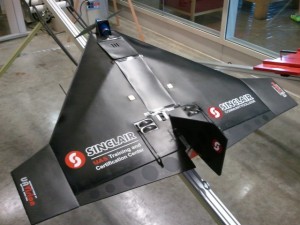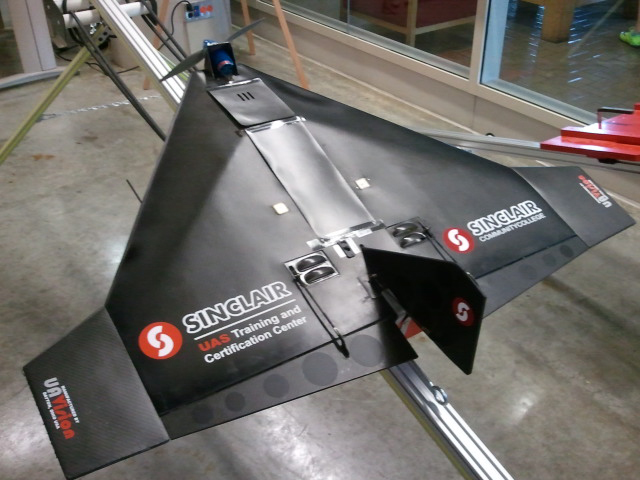
Sinclair Community College has recently purchased “The Micro,” a small unmanned aerial system (SUAS) from UTC Aerospace Systems.
This addition compliments Sinclair’s growing fleet of Unmanned Aerial Vehicles (UAVs). The fleet consists of one vertical take-off UAV that can be controlled via smartphone app, and two “Spears” that are launched from a guiding rail, and land, or are “caught” in a small, stationary net.
The newly acquired small UAV is hand-launched, can be maneuvered or set to autopilot, and will land on its composite belly, which can sustain even the grind of concrete if forced to land in an urban environment.
The SUAS has electrical optic capabilities and can sustain flight for approximately 60 minutes. It can travel at speeds between 35 and 52 mph and it can fit in the trunk of a car.
Deborah Norris, vice president of Workforce Development & Corporate Services, said that her division ultimately wants a variety of UAVs that can be incorporated more broadly, while still showcasing the vehicles’ value to first responders, which includes fire departments, emergency medical technicians (EMTs), and police.
Norris believes that the goals of first responders are to have ease of use, and have the ability to achieve a different vantage point to obtain better assessments of emergency situations.
Norris said job potential for UAS operators will grow with the emerging market and she believes that it might result in a mix of contracted experts and trained employees within civil service.
“It’s going to be another tool for them to use in their professions,” said Norris. “It’s almost like when the personal computer came out. We knew it was going to be really big, but we really weren’t sure how each of us would adapt and use it over time.”
Norris said this preemptive move and investment by Sinclair is made in an effort to play a supporting role for the region and Ohio in regards to UAS development, and to create an educational pillar that can aid in the creation of a workforce possible of taking advantage of an emerging job market.
Norris added that in support of the Dayton Development Coalition, the Workforce Development division’s plan is to ultimately help create a national center for Unmanned Aerial Systems that can utilize the myriad of resources and assets that the Dayton area already offers.
The state of Ohio currently has its eye on and is vying for one of six sites being selected by the Federal Aviation Administration (FAA) that would allow further UAV testing.
“The important part for us is to closely monitor what the FAA is doing and which opportunities will present themselves first for the commercial and civil market,” said Jeff Miller, assistant vice president of Workforce Development. “And then we’ll want to be well positioned to align our training and education and certificate programs to prepare people for that.”
Sinclair is currently in the preliminary stages of organizing the information required by the FAA to add the SUAS to their Certificate of Authorization (COA), which would essentially allow the lightweight UAV to fly within the designated airspace of Springfield Airport.
Norris said that the Springfield Airport was chosen as the ideal location because its traffic patterns would best suit the COA requirements.
“Because it’s such an emerging market, what we’re trying to do is invest in assets that the college, both our division and the college credit side—can incorporate this into the student experience,” said Norris.
With new technology and developments comes new training and education, and Workforce & Development would like to see the UAS Certificate evolve into a two-year associate’s degree program that could lead students to a four-year UAS program.
Several four-year colleges, such as the University of North Dakota and Embry-Riddle University, now offer bachelor’s degrees in UAS.
“We want to help build this national center for UAS training and certification. We want to be early out to align the region’s assets with the growing UAS market,” said Norris. “So it’s really important that we make sure that Sinclair is at the cutting-edge.”


